
 The Amp Hour Electronics Podcast
The Amp Hour Electronics Podcast #673 – Lifelong Learning with Bitluni
Jul 15, 2024
Matthias Balwierz, also known as Bitluni, is a tech innovator famed for his MIDI pedals and video generation. He shares insights on lifelong learning in electronics and the significance of community. The conversation dives into fascinating topics like LED walls, sonar scanning technology, and FPGA advancements. Matthias touches on his projects, including the Browser assembler and the blend of art and technology in the demo scene. He also discusses challenges in memory management and the accessibility of DIY electronics through platforms like Tiny Tape Out.
Chapters
Transcript
Episode notes
1 2 3 4 5 6 7 8
Intro
00:00 • 3min
Beginner's Journey in Electronics
02:32 • 16min
The DIY Evolution: From PCB to FPGA
18:51 • 18min
Navigating Memory Management Challenges
36:53 • 6min
Exploring FPGA Experimentation and Development Resources
42:46 • 5min
Exploring the Tang Nano Series: Features and Applications
48:03 • 3min
Navigating FPGA Complexities
50:40 • 6min
Art and Code: The Demo Scene Journey
56:24 • 10min

